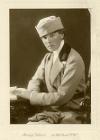Dr Louise McIlroy
Their names will be remembered for evermore
The Scottish Women's Hospitals were set up with the aim of using all-female staff to care for the Allied wounded. Scotland's first female doctors began graduating just before the turn of the century and by the outbreak of war, they had experience that they were keen not to waste. Louise McIlroy was one of the doctors who not only helped change society's view of women, but who, had they not been allowed to practise abroad, could not have saved many servicemen's lives.
Medical Sisters
Dr McIlroy graduated from Glasgow University in 1898. She worked as a surgeon in obstetrics and gynaecology at various hospitals in the city, and in 1911 gained a senior role with the university. Her sister, Jane, who graduated from Glasgow in 1904, became an eye doctor.
Male doctors were called to the front, and emergency committees tried desperately to cover medical services. Suffragettes and women doctors offered their services, but faced opposition. Dr McIlroy wrote: "It had been ordained that women could not fight, and therefore they were of no use in war time." When another doctor, Elsie Inglis, suggested teams of women doctors be sent to the Western Front, the War Office replied: "My good lady, go home and sit still." She didn't, deciding instead that women doctors would "have a unit of our own".
Pioneering Women
Dr Inglis raised thousands of pounds to set up the Scottish Women's Hospitals for Foreign Service. There were 14 medical units, serving in France, Corsica, Malta, Romania, Russia, Greece and Serbia. They were paid for by the National Union of Women's Suffrage Societies and the American Red Cross. Funds for units were also raised by voluntary groups or women's colleges such Girton and Newnham in Cambridge. Dr McIlroy was sent to France with this unit in 1915. After six months at Troyes, the unit accompanied expeditionary forces to Serbia and, later, Salonika in Greece.
Dr McIlroy, who had three sisters, wrote home about her unit's successes: "We are hoping to [teach] the French the enormous advantages of open air and sunlight for septic wounds. Our results have been simply extraordinary, no antiseptics at all." Another letter, from the camp in Salonika in July 1917, remarks on an inspector's happiness about the lack of flies. For a 200-bed hospital under canvas in the height of the Greek summer, it was quite an achievement.
Surgical Brilliance
A contemporary of Dr McIlroy's later noted that she "is one of a little band of notable women chief medical officers who made the name of the Scottish Women's Hospitals synonymous with surgical brilliance... on three fronts during the war."
After the war Dr McIlroy worked with the army, as assistant surgeon at the 82nd General Hospital in Constantinople. In 1921 she became the first woman chosen for a professorship in the London School of Medicine for Women. Her salary, £2,000, was the highest paid to a woman for university work.
Louise became Dame McIlroy in 1929, and helped to organise medical services for the Second World War. She and Jane retired to Girvan. Dame Louise died in 1968.
View original referenced text here:Dr Louise Mcllroy (PDF, 105 KB)(opens new window)
Images:
- Dr Louise McIlroy, in the uniform of the Scottish Women's Hospitals. Credit: © GSG CIC Glasgow City Archives.
- Dr Elsie Inglis, founder of the Scottish Women's Hospitals, photographed in 1916 and used in the biography written by her friend, the women's rights campaigner Lady Frances Balfour, daughter of the Duke of Argyll. Credit: Frances Balfour, Dr Elsie Inglis, London, pp136-7.
- Tent Hospital. Credit: The War Illustrated, Vol 2, p644.








